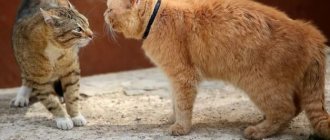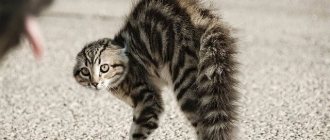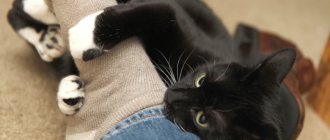If you are a cat owner or simply want to understand cat behavior, one question you may have is why do cats hiss? Most cat owners will attest to the fact that their furry friends sometimes display very unpredictable behavior; one moment you're having a good time, and the next you're caressing a scratch on your arm. Another common behavior is hissing. This is a snake-like voice that felines make to kittens, people, inanimate objects, and even other cats.
Cats have adapted to living indoors or near the house; this is due to certain difficulties that they have to overcome. Socializing with people and other pets is important to them, and vocalization, which can come in the form of hissing, is high on the list. Hissing is not only a sign of aggression; it can communicate different things.
To better understand hissing in cats, we'll start by looking at how the sound is made. We'll also look at eight different reasons why cats feel the need to hiss. Read on to find out more about this strange cat behavior.
Meow loudly, especially at night
Cats are nocturnal animals, which means that they are most active at night. They want to hunt, run and play. Cats sleep all day long, and at night they upset the whole house with their meows so that they get attention. Sometimes they may yell at a stray animal outside to leave, or call for mating if the animal is not neutered. Cats also meow if you haven’t removed their litter box or if you forgot to add food. To prevent your pet from disturbing your sleep at night, just before going to bed you need to play with your pet properly so that it doesn’t have the strength to play pranks.
Aggression
Cats are brave animals and thus demonstrate that, despite fear, they are ready to defend themselves. Such actions can also be caused by sudden movements of the owner, which the pet regards as aggression.
You can assess your pet’s condition by its appearance: it becomes tense, arches its back to appear larger, flattens its ears, and its pupils constrict. This appearance is characterized by a sharp surge of adrenaline and high concentration. The tousled fur gives the animal an intimidating appearance.
Do not punish your pet under any circumstances; after a while he will calm down and most likely come up to you and ask for affection. Try not to make sudden movements near the animal so that such situations do not arise.
They're climbing everywhere
Cats love high places. This gives them a sense of security and allows them to observe everything that is happening around them. In addition, they navigate by smell. When a cat climbs onto furniture, even if it is not very high, it leaves its scent. One way to correct this behavior is to install some shelves so your cat can climb on them, leaving your furniture alone. Make sure the shelves are aligned in such a way that your pet can jump from one to the other.
Hissing as an expression of dissatisfaction and readiness to attack
The ability to see the reasons for a negative reaction and predict further actions underlies the problem-free coexistence of a person and a freedom-loving cat in the same territory. In order not to aggravate the conflict with the hissing cat, it is strongly recommended not to:
- Imposing your company on the cat and pestering it with food or toys . A pet who is in a bad mood has no time for entertainment, and his appetite at such moments noticeably worsens.
- Try to calm the cat by stroking it . At the moment of inflated feelings, a pet may react inappropriately to an outstretched hand, hitting with a clawed paw and leaving a bloody trail.
- Take the cat in your arms and cuddle it . Most likely, such an attempt will immediately fail, and the angry or frightened cat will become even more furious. Some pets may freeze for a moment in the owner’s hands, but then begin to break free with renewed vigor, dodging and using their teeth and claws.
- Block the animal's escape route . The running cat defiantly asks to be left alone. But if the owner is persistent and begins to chase the animal or tries to detain it, he will certainly cause an outbreak of aggression.
- Trying to get the cat out of hiding. A cat's house is an inviolable personal space, so there should be no intrusion from the outside. An animal huddled in a nook is in a state of stress and seeks salvation in an accessible shelter, and if it tries to bother you, it will most likely launch a serious attack.
Spinning under your feet
Cat owners often face a similar situation. They do this to get your attention. The more animals meow and get underfoot, the more they need your care and love. They either want to eat or want to be played with.
Cats may also circle around to draw your attention to what is happening around them. These animals have repeatedly warned people about carbon monoxide emissions, fires, diseases, injuries and much more. So, if your pet is not hungry and does not want to play with you, be sure to look for other reasons for his dancing around his feet.
Main causes of hissing
A cat is an emotional and very sensitive creature. Don’t think that she shows her mood less than a dog. The cat just has a different language of communication. It is less visible and less understood by people. Hissing brings together a wide range of feelings:
- Aggression. Aggression is rather a collective term. It combines all the negative emotions that a cat experiences. An animal that is not large in size, but is considered a predator, cannot solve problems in any way other than aggressive defense. The cat rarely attacks, only during the hunt. Everything else is nothing more than protection.
- Irritation. A pet can experience this feeling for a variety of objects. The most common irritants are children. They often cause negative emotions in a cat with their mobility and can cause pain or other discomfort. Hissing is a menacing sound. It repels the irritant well, and he is forced to leave the animal alone.
- Pain. If a cat is in pain, the best thing it can think of to protect itself from unnecessary attention is hissing. It is unlikely that anyone would want to touch a pet in such a state. The gaping mouth with sharp fangs looks painfully impressive, and even more so the claws. Physical discomfort is a direct signal of the animal’s current incapacity. How else can a cat save and protect itself from the threat? Just to show that she can stand up for herself.
- Fear. Here comments are unnecessary and speak for themselves. Pain and fear usually go hand in hand. Therefore, the manifestation of emotions is the same and is accompanied by hissing. There is only one meaning: protecting yourself. Typically, the manifestation of fear is accompanied by more than just hissing. The cat bristles its whiskers and fur, trying to show that it is a very large animal and definitely not worth messing with.
“I’m big and scary, it’s better not to mess with me,” the cat seems to say when it hisses and bristles its fur
- Warning. The cat doesn't like to attack at all. She's too small. But despite all this, she’s not stupid. She knows perfectly well whether she can cope with the enemy or not. But this is in the wild. It's different for domestic cats. The pet knows its owners well, it trusts them, but if they cross the boundaries of subordination, then before putting the offender in his place, the cat sends a warning in the form of a hiss. This works well on those who have the audacity to disturb her peace.
- Sexual irritation is a more complex feeling. There is a whole range of relationships here: protecting the boundaries of the territory, the fight for the female, possessive instincts. The hissing is intended to both warn and scare the opponent.
- Danger. Danger is always accompanied by fear. The desire to defend herself, to show that she can fight back, will be accompanied by the cat's hiss. This is how the animal conveys a warning to the offender or a signal of danger to relatives or owners.
Video: reasons for aggressive behavior in cats
They rub against you when you come home
As mentioned earlier, cats live by smell. If the house is filled with their own scent, they are happy. To achieve this, cats rub against things to leave their scents. They have smelly pockets all over the place, and when they rub things (quite often your feet), they leave a smell. When you leave home and then return, you pick up odors from everywhere you go. Your cat will check and then re-mark you with her own scent.
Your pet can also smell another cat, even if you accidentally touched a bush where the animal previously left its mark. You don’t feel this because humans, unlike cats, do not have such a keenly developed sense of smell. Therefore, when your cat sniffs you, he actually smells a foreign odor and tries to get rid of it in this way.
It’s good to wash often: myths about shampoo and hair care that only harm
Rare shot: Viktoria Isakova showed her grown-up daughter from Yuri Moroz (new photo)
The money tree pleases with lush flowering: my secret is in caring for the leaves
Mimicry in the animal world
In nature, living beings often deceive their enemies. Some stand on their hind legs or raise their fur, or spread their wings, as if increasing their size. Some insects disguise themselves as bees, and one type of beetle even buzzes when threatened. Rattlesnakes produce a rattle sound, and almost all of them hiss. Zoologists believe that the hiss of cats is copied from snakes, since everyone is afraid of these reptiles, including the enemies of cats. All these tricks mean “I’m bigger and stronger, it’s better not to interfere.”
© shutterstock
Showing belly
Cats live by instinct whether they are in the safety of a home or outdoors. By keeping the most vulnerable areas protected, they remain safe. If your cat feels comfortable around you, she may often show her belly to show her trust. If you try to touch her belly, be careful because some cats may scratch or bite.
Division of territory
The dog becomes attached to the owner, showing boundless devotion. But cats get used to their habitat. That’s why they carefully protect their territory. At the same time, cats mark all corners of the surrounding area. And cats can hiss at an uninvited guest, even if he is several times larger than them. That’s why you can often see a cat hissing at a dog or other animal. Moreover, if this is the territory where a dog is usually located, the cat will not hiss at it, but on the contrary, it can rub against its legs, maintaining a friendly alliance with a stronger animal.
How to respond to a growl
Several rules will help relieve tension between you and your cat, the choice of which depends on the cause of the conflict:
- if aggression is associated with illness, take your pet to the clinic;
- when demonstrating a fighting spirit, wait 10–15 minutes until the pet calms down (it is better to go to another room during this time);
- after the cat has come to its senses, pet it, talk to it and treat it to something tasty;
- do not stop the cat from growling at your brood - this is one of the methods of education;
- if the cat’s fighting qualities are innate, just come to terms with this fact - you won’t influence the genes, so accept and love your bully for who he is.
Return to content
Breed trait
Hissing can also be a manifestation of the breed's temperament. Animals that are characterized by a quick and vivid reaction to what is happening are prone to such a reaction: Siamese, Egyptian Mau, Abyssinians and others. Lack of physical exercise does not benefit them: pets become grouchy. And Persian and Siberian cats are jealous of the cleanliness of their fur and can become angry if it is touched frequently.
Previously, “Profile” also told how to understand that a cat is getting old. There are four main signs.











